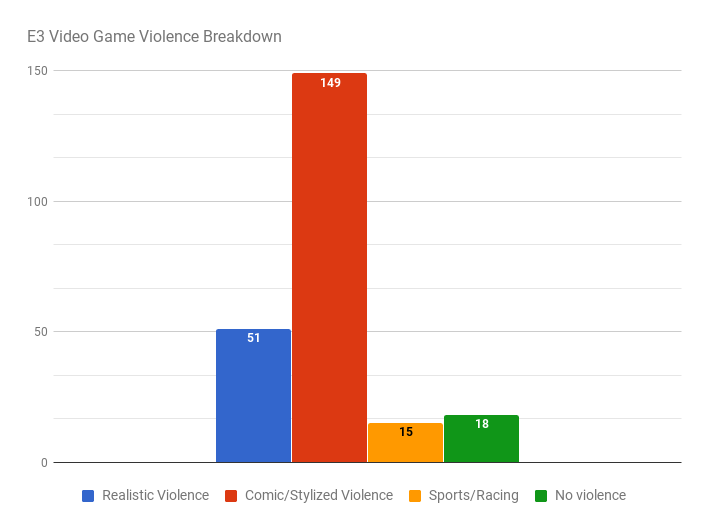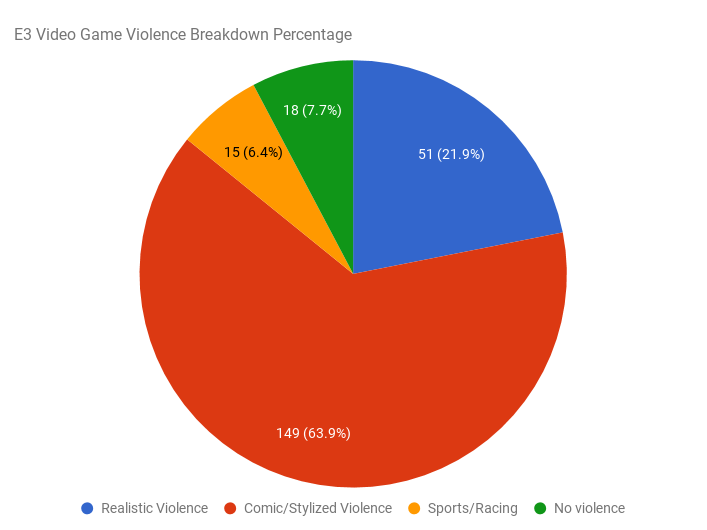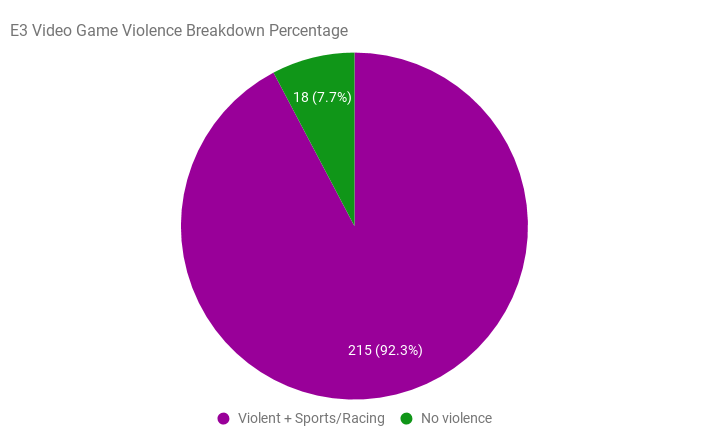Video Games at E3 are Obsessed with Violence
Jun 29, 2017When you think of video games, what’s the first one that comes to mind? One of the Super Mario Bros. games? Perhaps an old childhood favorite like The Legend of Zelda or one of the games on your phone that you’re playing in your spare time like Clash Royale? Maybe it’s even Minecraft. Now that you’re thinking of a game, does it have violence in it? I’m willing to bet the majority of you are thinking of a game that does, even if it’s just Mario jumping on people’s heads.
The Electronics Entertainment Expo (or E3) was two weeks ago, and I couldn’t help but notice – most of the games at the expo had violence in them. The violence ranged from the ultra bloody State of Decay 2 to the classic Mario jumping on Goomba heads, but it was almost always there. It got me thinking – what percent of games shown at E3 had violence in them and which ones didn’t?
The Data
Thanks to IGN‘s mostly complete wiki of games shown at E3, I was able to watch the trailer for 233 games demoed and categorized them into one of four categories:
The Categories
Realistic Violence: This is where one character (usually player-controlled) is physically attacking another character in a bloody, gory, and somewhat realistic way. Grand Theft Auto, State of Decay, The Walking Dead, Battlefield, and Uncharted all fall under this category.
Comic/Stylized Violence: This is any kind of violence where one character is physically attacking another character. This includes all of the Mario games, Final Fantasy, Pikmin, Pokémon, Hearthstone, and many many more.
Sports/Racing Game: These games consist of racing games and traditional sports games like golf, football, soccer, and basketball. The usual suspects of Madden, NBA Live, Gran Turismo, Rocket League, and FIFA fit into this category.
Non-Violent: These games all have zero violence in them. Very few games fit this category – even games like Minecraft have a small subsection that contains violence although the main part of the game doesn’t. Most of the games I looked at fell easily into one of the categories, but a few games were on the edge between realistic violence and comic/stylized violence. In those few cases, I made a judgement call, which didn’t greatly affect the data because of how many games I looked at.
Why the Sports/Racing category?
I categorized this separately because even though sports and racing video games do not have directed violence in the sense that you can attack another person or character, the activities they are based on and their origins are often quite violent. People who play sports break bones, get concussions, and can even die while competing. Racing is even more deadly, especially if you look at one race in particular which is more likely to have a death every year than not, with the most deaths in a single year being eleven (!!!).
The video game versions of these sports aren’t as bloody or deadly as real life, but they mimic the real life activities accurately enough to often feel violent. Some games even go so far as to say the violent collisions are a feature of the game. There is a difference between directed violence and the violence in sports, but enough violence exists even in the video game versions to warrant a separate category.
The Results
After analyzing the data1, the graphs showed me that most games shown at E3 did, in fact, have violence in them.

As you can see, the vast majority of games have comic or stylized violence in them with realistic violence coming in at a distant second. It’s a little hard to tell how large of a percentage those categories are from bar graphs, so next is a pie chart with the percentages.

Now it’s even more apparent just how many games feature violence in them in one form or another.

And lastly, when you single out the non-violent games, it’s astounding how few of them there are.
Which Companies are Making Non-Violent Games?
There were so few non-violent games shown at E3 that I can list them here:
| Game | Developer |
|---|---|
| Anamorphine | Artifact 5 inc. |
| BestLuck | Jae Cloud Yoo |
| Chess Ultra | Ripstone Ltd. |
| Coma Remembered | Serenity Forge |
| Harvest Moon: Light of Hope | Natsume |
| Harvest Moon: Lil’ Farmers | Natsume |
| Just Dance 2018 | Ubisoft |
| Manifest 99 | Flight School Studio |
| Roto Color Rhythm | Blue Volcano |
| Semblance | Nyamakop |
| Sumer | Studio Wumpus |
| Surviving Mars | Paradox Interactive |
| Tacoma | Fullbright |
| The Artful Escape | Beethoven & Dinosaur |
| The Inpatient | Supermassive Games |
| The King’s Bird | Serenity Forge |
| Tornado Tower | Dizzy Slugs |
| Where the Water Tastes Like Wine | Dim Bulb Games |
Which developers made those games? It turns out, only one of them is being made by a big name company. One. Just Dance 2018 by Ubisoft is the only non-violent game from a large company at E3. There are three by smaller companies like Paradox Interactive (Cities: Skylines) and Natsume (Harvest Moon), but the rest of the non-violent games come from indie companies. I’m positive there are non-violent games being made by the larger companies, but why are they not being promoted and shown at E3? Why is the focus of this event primarily on violent games?
Why so much Violence?
Most video game have a majority of literary elements in them including Characters, Setting, Plot, Theme, and Conflict. The conflict in video games is often physical violence as it’s easy to convey when an action is good or bad. It is easy for players to understand that violence against the player is bad and violence against opponents is good. Video games have featured this design mechanic going back to one of the first widely available video games ever created.
We’ve been making video games for over 55 years that feature violence as a form of conflict, so we’ve had quite a bit of time to get good at displaying it in different ways. You can shoot people, stab them with swords, jump on their heads, punch them, eat them, drive over them with a car, blow up spaceships, and have one of your cards attack and damage another card. Yes, that last one feels a bit silly compared to the others, but it’s still a form of physical violence which the Entertainment Software Rating Board (ESRB) categorizes as Fantasy Violence.
My theories as to why
-
Games are incredibly difficult and time consuming to make, so because there is an extensive lineage of games with violence, developers are able to use those common design patterns to not have to explain mechanics new to players. In a Mario game, you know you can jump on an enemy’s head because you have 30 years of experience telling you it’s good to do so. Many non-Mario games allow you to jump on enemy’s heads to deal damage for this very reason. Finding new mechanics that work to convey good and bad actions is incredibly time consuming, so developers have chosen violence as the easy path. It sounds lazy, but when developers are facing the difficult task of finishing and shipping a game, they’ll take any easy wins they can find. Violence is easy to create and contain in a game design, and so is often the first choice.
-
Games are made predominantly by young, white men. In the IGDA’s 2016 diversity report, 75% of responses identified solely as white (81% for white multiracial) and 72% identified as male. The report even goes on to say “This data presents the prototypical game industry worker as being a 32 year old white male with a university degree who lives in North America and who does not have children.” Because game developers, as a group, aren’t very diverse, the games they create aren’t either. Their common background, and the history of violent games, doesn’t easily allow new ideas that would work in place of using violence as a game mechanic. The people making games have played the older, violent games and use those as a basis for creating new, violent games.
Is 2017 representative of violent games at E3?
Feminist Frequency has been tracking the violence shown in games over the past 3 years at E3, and the trend has largely stayed the same. They use a slightly different categorization method than I do, but you can see in their 2015, 2016, and 2017 posts that it’s very similar to what I’ve shown here. 2017 wasn’t a unique E3 with regards to violent video games. It would be interesting to see if Steam, iOS/Android, and consoles have an equivalent percent of violent video games on their platforms, but even if they don’t, it’s interesting that the games developers choose to show at E3 have so much violence in them. If game developer create more non-violent games, why do we choose to promote the ones with violence at E3?
Why is this an issue?
There are an infinite amount of games we could make, but right now the games shown at E3 are almost entirely violent games. That’s sad to me. I want to experience all of the different types of games possible, not just the ones we have now. I want more games like Astroneer, The Witness, Bounden, The Stanley Parable, Gone Home, and Flower. We can’t have those different types of games without also changing which mechanics we use and focus on.
Also, media influences how you perceive the world, so it’s important to remember that games developers create influence those who play them. Feminist Frequency has been successful at changing how developers portray women in their games for this very reason. It is important to have a variety of design mechanics otherwise people who play games could be influenced to think that violence is the only answer to conflict.
Should we stop creating violent games?
No. Just because we’re overdoing it right now doesn’t mean we should stop entirely. Rather than having violence be the default conflict game mechanic, I would like everyone making games to be intentional about picking violence. If a game calls for it because you’re doing something that relies on violence as the sole way to explain what’s going on, then it absolutely makes sense to use it there. If game developers are doing something that would work with non-violent forms of conflict, then they should explore those other types of non-violent mechanics.
Violence is the easy answer to many game design choices, but it shouldn’t be the only tool we have in our bag. We can develop others that are just as good as violence, it’ll just take some thought to do so.
